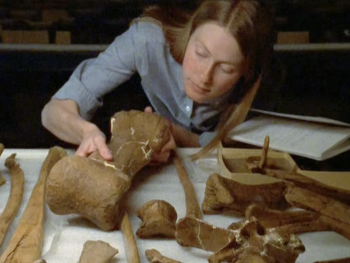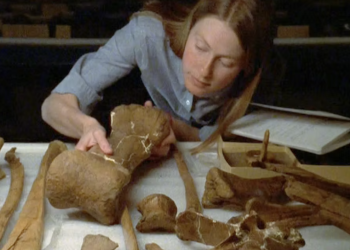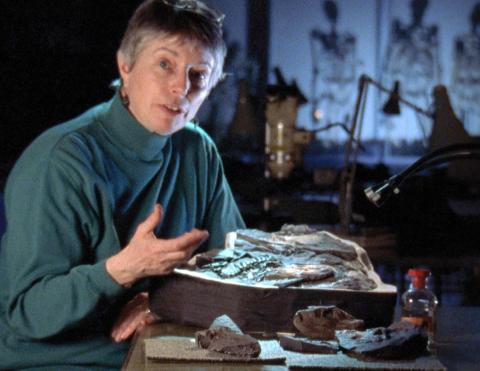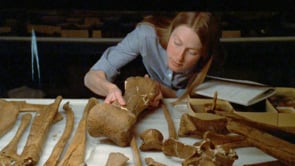
There's a good evolutionary reason for growing quickly. Basically, you have to grow fast so you can beat out the predators and be an adult and reach sexual maturity in time to actually reproduce and send your genes on through the gene pool. -- Kristi Curry Rogers
Paleontologist Kristi Curry Rogers studies ancient fossils to determine how fast dinosaurs grew. Because the bones of modern day reptiles grow slowly, scientists assumed that dinosaurs grew slowly as well. Experts had estimated that it might have taken up to 120 years for an enormous Apatosaurus to grow to its full length of 70 to 90 feet. To Curry Rogers, this didn't make sense.
In Bozeman, Montana, she found fossilized Apatosaurus bones and set out to determine the rate at which the dinosaur had grown. Curry Rogers realized that the interior of the bones contain a record of the animal's growth. She prepared a bone slice one tenth of a millimeter thick and looked at it under a microscope. If the animal had grown slowly, patterns created by the blood vessels in the bone would have been arranged in an orderly fashion. But Curry Rogers discovered that placement of the vessels was irregular. She concluded that Apatosaurus might have reached its full size in as few as 10 to 12 years.
About Kristi Curry Rogers career
Kristi Curry Rogers, Ph.D. is an Associate Professor of Vertebrate Paleontologist in the Geology and Biology Departments at Macalester College in St. Paul, MN. She holds a M.Sc. in Biology from Montana State University, and a Ph.D. in Anatomical Science from the State University of New York at Stony Brook.
Curry Rogers has been interested in dinosaurs since she was six years old and vowed to be a paleontologist when she grew up. Her primary focus is on the evolutionary relationships and biology of titanosaurs. Her Ph. D. research involved naming, describing, and deciphering the anatomy and relationships of two brand new titanosaur species from Madagascar.
Curry Rogers is interested in the evolutionary history and paleobiology of dinosaurs, primarily the long-necked, herbivorous dinosaurs known as sauropods. In terms of broader paleobiological questions, she uses bone histology (the study of the microscopic aspects of bones) to explore and reconstruct patterns of the evolution of body size, growth rates, and life history strategies among dinosaurs, their living relatives, and their modern analogues. Specifically, studying fossilized bone can provide a glimpse into how quickly dinosaurs grew, how long they may have lived, and even when they reached their adult sizes. Studying tissues in living animals, like birds, crocodiles and mammals, offers Curry Rodgers insight into understanding similar features in extinct animals. In addition to teaching, she does field work around the world and studies dinosaur fossils in the lab.



















